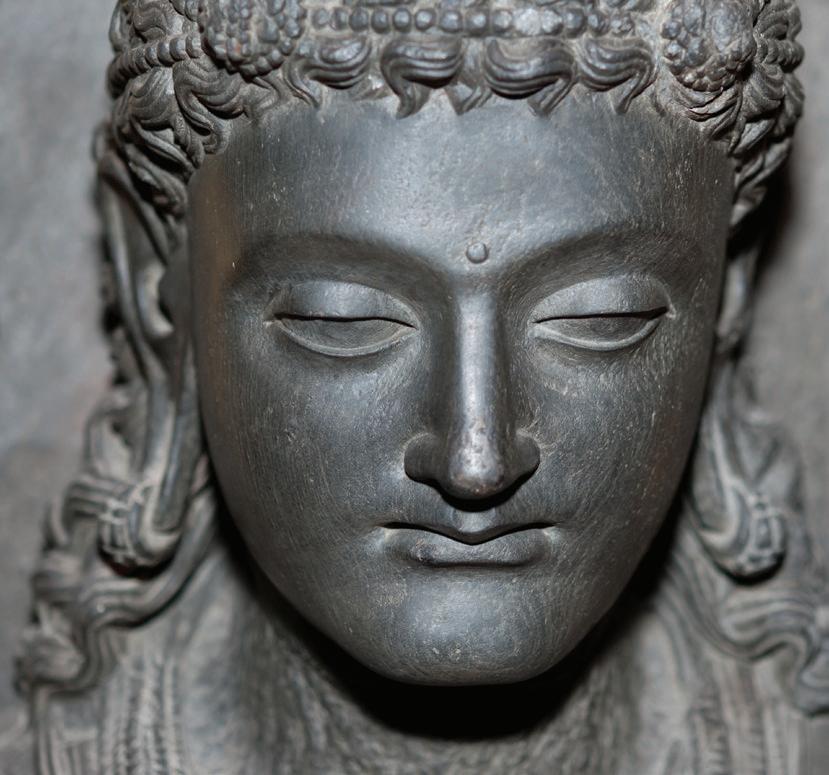
5 minute read
Schist Buddha of Gandhara
By Huma Wasiq
Gautama Buddha lived in 6th century BCE, whose teachings were adopted by Gandhara civilization: a well settled area along the river Kabul, but this valley always gave way to the invaders from Afghanistan and further north and west. Most of these conquerors advanced further into the sub-continent, but few stayed here and exchanged their cultural and religious traditions, leaving behind a new impact.
Advertisement
ways of life and left impressive impacts on this region. Chandragupta’s grandson Ashoka (273-232 BCE) was a zealous missionary worker who first served as governor in two places in Chandragupta’s reign and then became king. After extending his empire in this region he became Buddhist in 261 BC. Hence another influence was printed in the history of this region.
Ashoka erected stone pillars all over his empire on which teachings of Buddha and rules of conduct were carved in Buddhist scripts.
Towards the end of 6th century BC, Cyrus, who was also called Cyrus the Elder by the Greeks, conquered Indus valley and became first conqueror ruler of Gandhara kingdom. This is how the Persian architecture and Karoshthi script was introduced to ancient India.
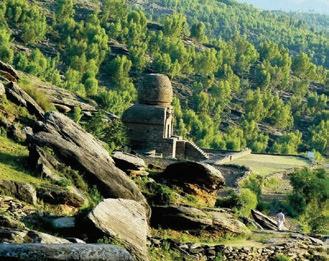
In 327 BC, Alexander the Great also stayed at Gandhara valley under the reign of Raja Ambhi of Taxila. This military genius found Taxila as a great seat of learning. He found books on medicine, law and the sacred books of that time, which were written under the Persian influence. Exchange of religious and cultural influences with Persia continued for almost 200 years in this region.
The Greeks had ruled for short time in north-west India. However, the descendants of Greek garrisons established themselves in the Peshawar valley and Taxila. So the Greek influence came to be felt in the region, which is now Pakistan, especially in the sculpture, which flourished in all the towns of Gandhara.
Gradually Greek influence also defused by Asian Hindu king Mauryas (Chandragupta II). This remarkable king organized his kingdom by developing roads, trade, social and domestic life. Socialization and trade lead to new
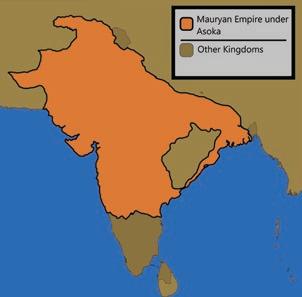
These Buddhists wanted to preserve the relics of Gautama Buddha, But after Sakas (20-48 CE), Kushans (48-220 CE) and Kanishka (120-162 CE) from Chinese background, Buddhist philosophy changed. The impact of Brahmanism, made it more complex and Buddha was given a divine status.
Collecting all the influences from Rome to China, the images of Buddha appeared for the first time in 2nd century CE, on the coinage of Kanishka. Temples were now decorated with sculptures; depicting the life and death of Buddha. Gradually these sculptures of Gautama Buddha were enhanced by different symbols, posters and designs. The artisans used Schist as material, which is sometimes also found with traces of pigments and gold applied on it. We can find relief of Buddha even today in North of Pakistan including Peshawar, Skardu, Gilgit, Hunza and Swat valleys.
As an artist, creating awareness about a tiny particle from our strong history, I tried to paint one of these Gautama Buddha sculptures from Swat valley on my canvas. With a landscape from Swat valley in the background, this seated
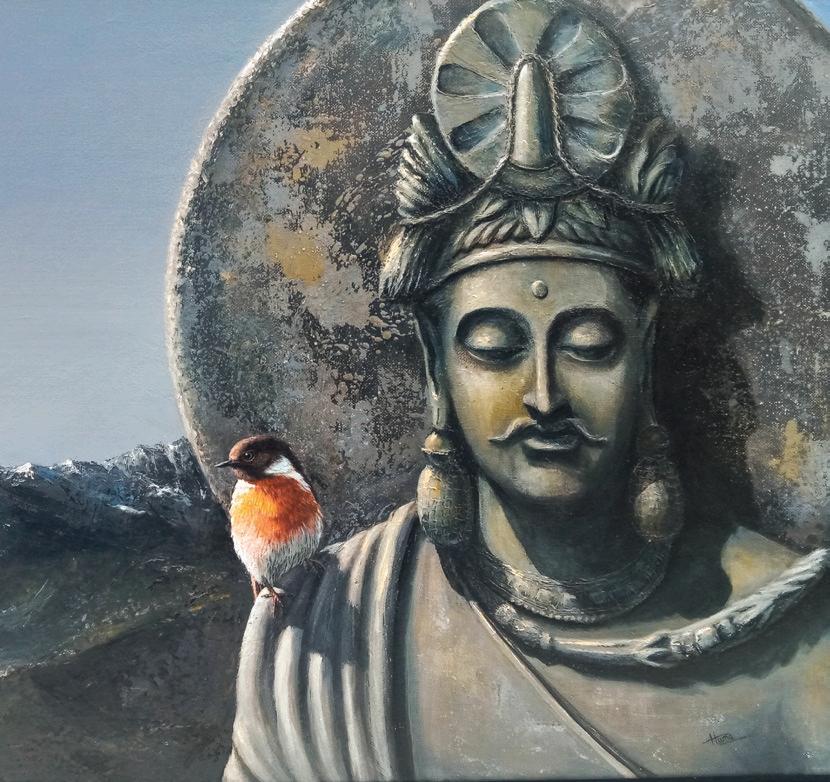
Buddha represents many symbols apart from the strong above-mentioned history.
Buddha of Gandhara was never sculpted/ painted with out Halo at the back of his head. This halo denotes Buddha’s divinity and spiritual radiance. The protuberance on the top of head shows super mental acuity.
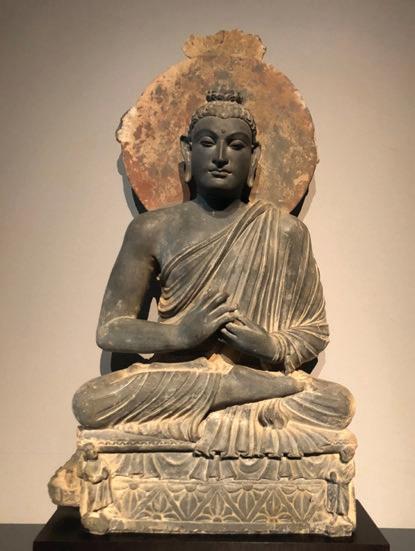
The long earlobes are due to heave jewelry which he wore as a prince and represents perception of supremacy as well as his renunciation of princely status. The eyes in this sculpture are designed half close which represents his meditation. Its heavy jewelry represents his princely status. The moustache grows outwards above the upper lips curved subtly, showing early age of Buddha.
Although this beautiful sculpture is now well preserved in Lahore museum but a bird on his shoulder represents the valley of Swat.
This small sparrow bird is resident of the same valley from where this beautiful civilization once belonged. Saxicola Torquata, commonly known as Bush chat or Stone chat, lives in plains as well as in mountains of Pakistan. It has an
About the Wrtiter
important role in the ecosystem as it is an insect eater and controls the exceeding population of insects that might disturb the balance in the biodiversity of the habitats.
The use of mix medium colors on my canvas are not merely strokes of brushes or use of tools, but it is also my attempt to depict our interesting history, beautiful nature and the environments of these historic civilizations.
Huma Wasiq is a nature artist from Pakistan with MFA degree from Punjab University. She has received many academic and merit awards, including Presidential Award and Special Artist Award 2018.


Details of events from April to June 2023
Arabian Travel Mart, Dubai
Pakistan Showcased its Rich Tourism Potential in World Leading Travel Show - Arabian Travel Mart (ATM) Dubai, 2023. A 25-members delegation of Pakistan under the leadership of Mr. Awn Chaudhry, Advisor to Prime Minister on Tourism and Sports including Trade Development Authority of Pakistan (TDAP), Embassy of Pakistan in UAE and 10 to 12 private stakeholders participated in ATM from 1-4 May,2023 to showcase the rich tourism potential of the country.
colourful cultural performances, music, dance, and traditional sports.
Pakistan Tourism Development Corporation (PTDC) showcased Pakistan’s rich tourism potential at biggest tourism fair of Korea “Seoul International Travel Fair 2023” which was held from 4-7 May,2023 in collaboration with Pakistan Embassy at Seoul and TDAP.
Vesak Day
On 7 May,2023, Pakistan Tourism Development Corporation (PTDC), in collaboration with the Gandhara Resource Centre Pakistan (GRCP), Guangdong Guangji Foundation, Paper Miracle, Centre for Culture and Development and the Department of Archaeology and Tourism Punjab successfully organized a grand Vesak Day event at Taxila Museum. “Vesak”, the Day of the Full Moon in the month of May, is the most sacred day to millions of Buddhists around the world.
Exploring Gandhara Civilization
On 7 June,2023 PM’s Task force on Gandhara tourism that comprised of Dr. Ramesh Kumar, Chairman PM Task force on Gandhara tourism & other foreign dignitaries made a visit to World Heritage Site Takht i Bahi Mardan, Shah Allahditta Caves, Islamabad & Buddhist archaeological sites of Swat for exploring the Gandhara civilization, its associated Buddhist, Hindu and Jainism art and architecture.
Tourism Working Group Meeting
Chilam Josh Festival
The four-day Chilam Josh Festival was held in three Kalash valleys, including Bumburet, Birir and Rumbur from May 13th to 17th May, 2023.
The Chilam Josh festival is a celebration of the arrival of spring and the melting of snow, and is characterized by
PTDC & Fascinating Pakistan MOU
An MOU was signed between Managing Director, Pakistan Tourism Development Corporation (PTDC) Mr. Aftab ur Rehman Rana and CEO of Pakistan’s first tourism magazine, Fascinating Pakistan Mr. Tahawur Husain Jafri to join hands for the promotion of tourist destinations of Pakistan, its rich cultural diversity, cuisine, arts and crafts & promotion of different events related to tourism.
The Managing Director-PTDC, Mr. Aftab ur Rehman Rana participated in the Tourism Working Group Meeting at Tbilisi, Georgia on 12-13 June to discuss the investment priorities for sustainable tourism development across the CAREC region and discussed plans for the launch of a tourism portal that will support the countries and private sector in stimulating tourism growth. The Working Group also reported to the CAREC Senior Officials Meeting the key deliverables on priority projects, climate resilience and a capacity building program for tourism development in the CAREC region.











